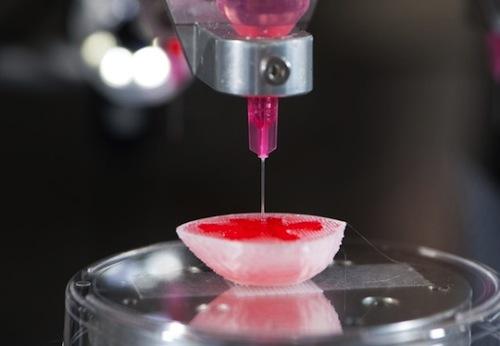January 21, 2013

While some hobbyists are rapidly prototyping items and objects from 3D printers, others in the medical field have taken that tool to a whole new level in printing out actual implantable tissue and even organs that could prolong life.
In the last few years, medical science has used 3D printers to replace damaged tissue (skin) or to restore limbs for those who have suffered wounds. While the procedures used so far are astounding in concept, they can't quite compare to what scientists from the Wake Forest Institute for Regenerative Medicine are developing using a hybrid 3D printer.
The group has recently made advances in simplifying the printing process for creating implantable cartilage-constructs that could be used to help regrow damaged cartilage in areas such as joints. This advancement was due in part by creating a hybrid 3D printer, which makes the overall process easier and is the combination of an ink jet printer and an electrospinning machine.
These two pieces of technology combined is the key to creating the cartilage-constructs as it combines both synthetic (for strength) and natural (gel used to promote healthy cell growth) materials. The scientists used the electrospinning machine to generate an electrical current through polymer solution to create very fine fibers. The process allows the scientists to control the composition of the polymers, which coalesce into porous structures and allows the cells to integrate into the surrounding tissue.
Click the image below for more images of the hybrid 3D printer fabricating implantable cartilage.

They tested their findings using layered flexible mats of electrospun polymer, which were combined with a solution of healthy rabbit ear cells deposited using the ink jet printer. The resulting constructs were then stress-tested for strength using variable weights, which were found to be robust and still alive after one week of testing. These constructs were then introduced into living mice in a controlled environment for two, four, and eight weeks to analyze how they would function in a living system. After eight weeks, the constructs developed the structures and properties of that of elastic cartilage, which is promising for use in human patients.
The Wake Forest scientists haven't limited their study and development to just cartilage. They are looking into developing bio-printing of dental implants, prosthetics, and organs, as well. According to the scientists, development of printing dental implants is progressing considerably. An implant can be fabricated using a digitized intra-oral scan to gain a blueprint of sorts, which can be emailed to a dental lab for precise printing of the patient's teeth. Not only is the process significantly cheaper, but it can be done quicker than any past method.
The same can be said for advancements in prosthetic limbs using 3D printing technology. Until recently, prosthetics were fabricated by shaving a piece of foam into the approximate form of a patient's limb and transformed into a mold where a polymer representation is then fabricated. This is not only time consuming, but also expensive, as well as painful to the recipient. Companies such as Bespoke Innovations have capitalized on this technology to custom print artificial limbs based upon the patient's dimensions. The company first interviews the customer to get an overall picture of their personality, such as interests, and can then manufacture a completely one-of-a-kind limb made from a myriad of materials, colors, and designs to suit the individual needs of the customer.
Increased developments in 3D printing technology for bio-printing soft-tissue organs are on the rise, as well. Several scientific institutions are developing methods to bio-print transplantable organs, but their core outcomes involved are relatively the same. The process of bio-printing organs starts with a culture of replacement tissue, which is taken directly from the patient. This culture is then printed layer by layer, which eventually becomes a three-dimensional structure. Recipients of the newly-printed organs have a reduced risk of their immune system rejecting the organ, as it's made from their own cells rather than using a replacement organ from a donor. While bio-printing technology is still in its infancy, there have been great strides in achieving the lofty goal. Wake Forest succeeded in printing fully functional miniature kidneys that were able to filter blood and produce diluted urine back in 2003. The scientists have since been trying to develop even more sophisticated miniature kidneys, as well as scaled versions of a heart, liver, and even a uterus in an effort to successfully bio-print full-sized organs in the future. This could lead to longer living as limbs and organs could be replaced on a regular basis through a system of interchangeable, organic parts.
Related posts:
About the Author(s)
You May Also Like





